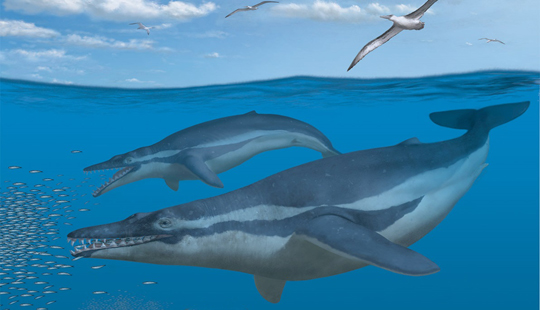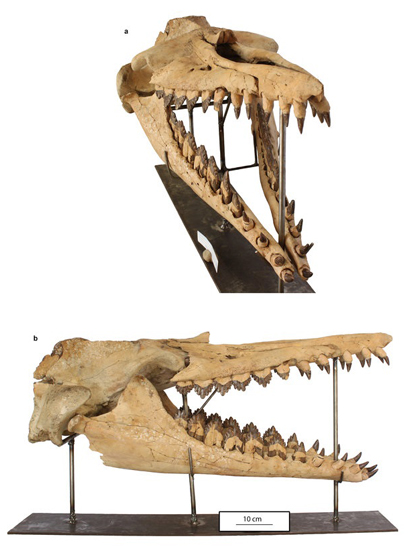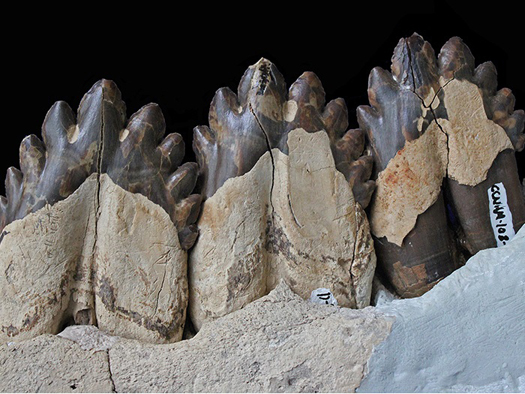New Research Outlines the Origin of Filter Feeding in Whales
Coronodon havensteini – An Important Transitional Fossil
The classification and evolutionary history of whales has been a source of fascination for many scientists. It was the famous Swedish biologist, Carl Linnaeus, who in 1758, defined whales as mammals and not fish.
Charles Darwin speculated on the origins of whales (Cetacea), if we at Everything Dinosaur recall correctly, Darwin proposed that whales and their smaller cousins, the dolphins and porpoises had a terrestrial ancestor, but the exact evolutionary history of this diverse group of vertebrates has yet to be fully unravelled. Step forward, the newly described Coronodon havensteini, the premolars and molars of this Oligocene-aged toothed whale have provided tantalising evidence suggesting how filter feeding in whales evolved.
Coronodon havensteini Hunting Fish
Picture credit: Alberto Gennari
The picture above depicts a scene off the south-eastern United States some thirty million years ago (Oligocene). A pair of Coronodon pursue a shoal of fish, whilst above, some toothed birds (Pelagornis sandersi), circle in the hope of picking off any injured fish that come to the surface.
Different Types of Whale – Different Types of Feeding
Although, all whales share a common ancestor, a terrestrial ancestor with teeth that hunted prey (raptorial behaviour), over the fifty million years or so, since the first ancestral whales, three main feeding strategies have evolved.
- Odontoceti – the toothed whales the most specious component of the Cetacea consisting of Sperm whales, the Beluga, dolphins, Orcas and porpoises.
- Suction feeders – within the Odontocetes, a number of genera have utilised their large, broad jaws and big skulls to help them suck prey into their mouths. Examples include many of the beaked whales and the bizarre Narwhal.
- Mysticeti – the baleen whales, much less diverse and specious when compared to the Odontoceti, these are the filter feeders and as such, they include the largest vertebrates to have ever existed, leviathans like the Blue whale (Balaenoptera musculus) and the Humpback (Megaptera novaeangliae).
Whilst scuba diving in South Carolina’s Wando River on the hunt for sharks’ teeth, geologist Mark Havenstein came across the well-preserved skull of an ancient toothed whale, one that seems to be a transitional fossil between raptorial toothed whales and the evolution of filter feeding cetaceans.
The Evolution of Baleen – Keratinous Sieves
Scientists from the Mace Brown Museum of Natural History, Charleston, South Carolina (where the holotype material currently resides), along with colleagues from the New York Institute of Technology College of Osteopathic Medicine (New York), prepared and restored the fossil, a subsequent study of the teeth indicates that this prehistoric whale, named Coronodon havensteini was starting out on an evolutionary path that would eventually lead to functional filter feeding.
The Restored Skull of the Oligocene Whale Coronodon havensteini
Picture credit: Geisler et al (Current Biology)
Coronodon havensteini
Writing in the academic journal “Current Biology”, the researchers propose that Coronodon represents the most basal member of the baleen whales (Mysticeti) found to date. The teeth at the front of the jaws are conical, pointed and demonstrate procumbent dentition (the teeth in the front of the jaw point forward, ideal for spearing slippery fish). These teeth indicate a piscivorous diet, that Coronodon actively hunted its prey (raptorial behaviour). However, a detailed analysis of the huge molars at the back of the jaws revealed something remarkable.
The molars show very little signs of wear from shearing or cutting up food, instead these teeth may have served as simple sieves to sift out smaller prey items from seawater. The broad, multi-cusped molars frame narrow slits and wear patterns on the cusps indicate a role in filter feeding.
This suggests that the Mysticeti evolved their baleen plates whilst they retained their teeth and that baleen did not evolve in the mouths of Odontocetes that specialised in suction feeding and as a result, lost their teeth.
The Specialised “Filtering Teeth” of Coronodon havensteini
Picture credit: Geisler et al (Current Biology)
Commenting on the implications for their discovery, lead author of the research paper, Associate Professor Dr Jonathan Geisler (College of Osteopathic Medicine, New York Institute of Technology), stated:
“The transition from teeth to baleen is widely contested, but our research indicates that ancient toothed whales relied on the spaces between their complex and enormous teeth for filtering. It appears that over millions of years, the teeth were retained until baleen became sufficiently large and complex to take over the role of filter feeding.”
Giant Filter Feeders
The newly erected genus name Coronodon comes from the Greek for “crown tooth”, a reference to the multi-cusped molars that indicate filter feeding. The species name honours Mark Havenstein who found the holotype. The researchers suggest that later lineages of ancestral Mysticetes relied on specialised molars to act as functional sieves with baleen evolving in the mouth too. At some point in the evolution of these whales a “tipping point” was reached with a shift from mostly teeth to mostly baleen in the jaw.
The bristle-like baleen of extant filter feeding whales is made from keratin, it hangs from the upper jaw and acts like a giant sieve, straining out tiny food particles such as krill.
The researchers conclude that Coronodon havensteini lends weight to the idea that filter feeding was preceded by raptorial, predatory behaviour and that suction feeding evolved separately.
The scientific paper: “The Origin of Filter Feeding in Whales” by Jonathan H. Geisler, Robert W. Boessenecker, Mace Brown, Brian L. Beatty published in the journal “Current Biology”
Visit the Everything Dinosaur website: Everything Dinosaur.




